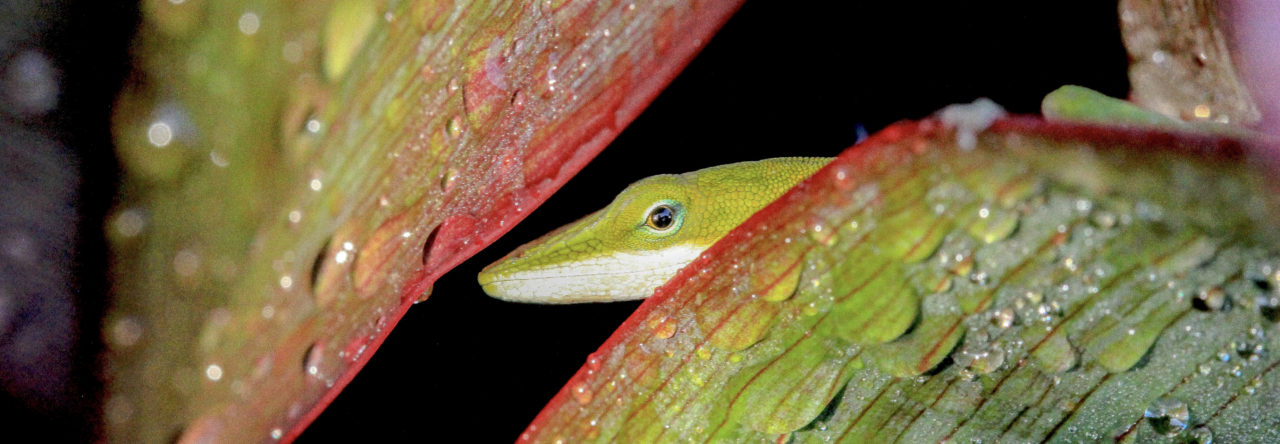A common concept in ecology is that predators have a strong influence on the behaviour of prey species. Anolis lizards have been used as a classic model system to investigate the effect of predator presence on the behavioural response of prey species. On small experimental islands in the Bahamas the manipulated introduction of curly-tailed lizards (Leiocephalus carinatus), a large terrestrial anole-predator, has resulted in brown anoles (Anolis sagrei) shifting higher up in the vegetation, presumably in an understandable effort to avoid being eaten (1, 2, 3). However, predator-prey interactions such as these which may shape community structure are often difficult to observe.
Here in Miami FL we have a rich and diverse, although largely non-native, lizard community. There are two species of “crown-giant” anoles, the Cuban knight anole (A. equestris) and the Jamaican giant anole (A. garmani), that could be potential predators of smaller anoles in the canopy of trees and upper half of tree trunks (although see Giery et al. 2013 for an empirical analysis that suggests this may not be the case). Additionally, there are several large, terrestrial lizards present which may be filling a similar role to curly-tails in the Bahamas.
Potential lizard predators in south Florida:
– *Red-headed agama (Agama agama)
– *Cuban knight anole (Anolis equestris)
– Jamaican giant anole (Anolis garmani)
– *Brown basilisk (Basiliscus vittatus)
– Spiny tailed iguana (Ctenosaura similis)
– Curly-tail lizard (Leiocephalus carinatus)
– Giant day gecko (Phelsuma grandis)
– Black and white tegu (Tupinambis merianae)
*Present at Fairchild Tropical Botanical Gardens
Earlier this afternoon, while taking a break from my office at Fairchild Tropical Botanical Gardens (a hot spot for any anologist visiting Miami; 1, 2, 3, 4) in a typical graduate student effort to put off work that I should be doing instead, fellow lab member Evan Rehm and I noticed some scuffling in a nearby bush. At around 2.5m, and admittedly on relatively precarious branches by this stage, sat an adult female African red-headed agama (A. agama) around 30cm from an adamantly motionless adult male Cuban brown anole (A. sagrei)! As we moved towards the bush the agama was quick to ungraciously thump itself to the floor, while the brown anole remained still. On closer inspection, it soon became apparent why both lizards were so high.

Adult male Cuban brown anole (A. sagrei) found ~2.5m high in Miami FL, supposedly following a predation attempt from an African red-headed agama (A. agama) – JStroud
The significance of tail loss/damage in a population is still debated. The classical view argues that high proportions of tail damage indicates high predation pressure, therefore prey populations are under high predation stress (1). Alternatively, high proportions of tail damage could indicate low predator efficiency, which would suggest prey populations are experiencing low predation stress (1, 2). But the debate doesn’t stop there! Having already lost a tail, a lizard may experience either a resulting increase or decrease in predation depending on the predator species and its associated foraging tactic (1).

The extent of tail damage is clearer in this photo. The lizard had autotomised the lower half of it’s tail however a secondary half-completed break is also evident – JStroud
African red-headed agamas (A. agama) are similar morphologically to curly-tailed lizards (L. carinatus), although are taxonomically distinct (Agamidae and Leiocephalidae, respectively). Predation of anoles by agamas in Miami has not previously been officially recorded, and the impact of these large predators remains unclear. Unlike in the Bahamas, there are multiple predators in the same geographic vicinity that anoles need to be aware of. For example, at Fairchild, brown anoles (A. sagrei) could be eaten from below by agamas, eaten at intermediate levels by basilisks and eaten from above by knight anoles!
South Florida is a tough place to be an anole!

Adult male African red-headed agama (A. agama) at Fairchild Tropical Botanical Gardens, Miami FL. The population of agamas is localised to the botanical gardens; the source remains unclear but is likely an introduction from the pet trade – JStroud














